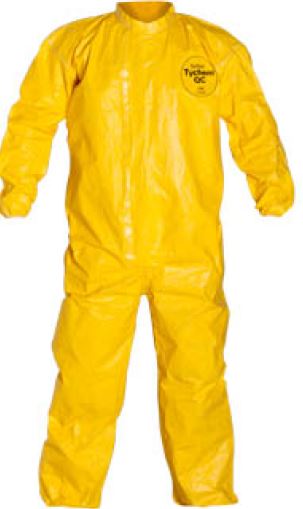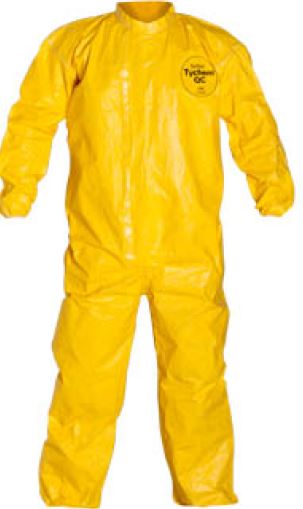COVERALL, no hood, L (Tychem QC 125T)
Valid Article
COVERALL, non hooded (Tychem QC 125T)
Definition
Personal protective equipment (non hooded) that fully covers the wearer's body from neck to ankles. Intended to be worn over a surgical tunic and trousers to protect medical and non-medical staff from exposure to inorganic chemicals and infective biological agents (e.g. Ebola).
Synonym
Protective clothing, protective coverall
Specifications
Quality Standards Comment
Protective clothing (PPE) Category III complex design:
- Chemical protective clothing Types 3, 4, 5, 6
- Protective clothing against infective agents Type 3B (liquid tight) and/or 4B (spray tight)
Meets the following European standards requirements:
- ISO 13688: 2013 (confirmed in 2019): Protective clothing, general requirements
Norms applicable to the fabric
- EN 368/EN ISO 6530: Resistance of materials to penetration by chemicals liquid
- EN 14126: Protection against infective agents from risk groups 1,2,3,4
- ISO 16603: Determination of the resistance ofprotective clothing materials to penetration by blood and body fluids, test method using synthetic, under hydrostatic = 20 kPa - Class 6/6
- ISO 16604: Determination of resistance of protective clothing materials to penetration by blood-borne pathogens, test method using Phi-X 174 bacteriophage, under hydrostatic = 20 kPa - Class 6/6
- ISO 22612: Test method for resistance to dry microbial (bacteria) penetration = log cfu ≤ 1 - Classe 3
- ISO 22611: Test method for resistance to penetration by biologically contaminated aerosols, using Staphylococcus aureus = log ratio >5 - Class 3/3
- ISO 22610: Test method to determine the resistance to wet bacterial penetration, when subjected to mechanical rubbing = > 75 min – Classe 6/6
- EN 14325: Test methods and performance classification of chemical protective clothing materials, seams, joins and assemblages
- Abrasion resistance: >2000 cycles - Class 6/6
- Flex cracking resistance: >100 000 cycles - Class 6/6
- Trapezoidal tear resistance: at least Class 3/6
- Tensile strength (max. tear): Class 2/6
- Puncture resistance: Class 2/6
- Resistance to ignition: at least Class 1/3
Norms applicable to the whole coverall
- EN 1073-2: Requirements and test methods for non-ventilated protective clothing against particulate radioactive contamination - Class 1/3
- EN 1149-5 & EN 1149-1 : Electrostatic properties - Class 2
- EN ISO 13935-2: 2004 : Determination of maximum force to seam rupture using the grab method = >125N - level 4/6
- EN 14605: Protective clothing Types 3-4: Protection against liquid chemicals (spray-tight)
- ISO 17491-4: Test methods for clothing providing protection against chemicals - Part 3: Determination of resistance to penetration by a jet of liquid (jet test) - pass
- ISO 17491-4: Test methods for clothing providing protection against chemicals - Part 4: Determination of resistance to penetration by a spray of liquid (spray test) - pass
- EN ISO 13982-1: Performance requirements for chemical protective clothing providing protection to the full body against airborne solid particulates (type 5 clothing) - pass
- EN 13034: Performance requirements for chemical protective clothing offering limited protective performance against liquid chemicals (type 6 clothing) - pass
Technical specifications
Fabric: Tychem QC
- Substrate of Tyvek® fabric (spunbonded olefin sheet made of high density polyethylene fibres) with additional polymeric coating
- Particle tight and waterproof fabric
- Lint-free, latex-free, halogen compounds-free
- Thickness: 180 μm
- Colour: light (optional: yellow outside, white inside)
- Anti-static treatment on inside
Model 125-DC
- Stitched and over-taped seams for better seam strength and to make it completely leak-proof and waterproof
- 2 elastic thumb-loops latex-free attached to the end of the sleeves:
- 1 large for thumb
- 1 smaller for little finger
- to provide good fit of the overall and prevent the sleeves from riding up
- Zipper:
- nylon on polyester braid with self-adhesive protective flap
- zipper teeth: plastic
- zipper puller: metal, min 2 cm long
- Elastic at wrists and large elastic at ankles: to ensure good fit and closure at critical points
- Mao collar: 3.5 cm
- Non sterile, for single use
Dimensions
Size based on body measurements taken while wearing a layer of underwear and without wearing shoes.
This chart is a guide for PPE garment selection. Proper fit varies with individual body shape and under clothing. Test garment for proper fit before use, as garment protection depends on selecting appropriate size.
Packaging & Labelling
Individual packing, 25 per box
Keep the coveralls in the boxes in order to protect the garment.
Instructions for use
Wearing the overall is mandatory:
- For medical and non-medical staff working in the high-risk zone of a VHF treatment unit
- For burial team in charge of preparation, transport and burial of corpses of people died of VHF and when carrying out disinfection of the morgue
- For ambulance team when transporting patients of VHF and carrying out disinfection of the ambulance
- For mobile team in charge of house disinfection
- For waste management staff when handling or disposing of VHF contaminated waste
- For all persons (staff and patients' attendants) in close contact with a patient with suspected or known VHF or SARS. Not suitable for family and visitors
Note:
The overall is part of the full personal protective equipment worn in VHF contexts (see the protective equipment module of the VHF kit).
Precautions for Use
- Wearers must receive appropriate training to advise why personal protective equipment is needed and its limitation, and when and how it is to be used
- Replace the overall if damaged
- When removing the overall follow the undressing protocol carefully
- Once it has been removed, it should be disposed of according to waste management rules
- Strictly for single use
Storage
Tychem® garments may be used for at least 14 years after receipt by the end user as long as all of the following conditions are met:
- The garment has been stored properly
- The garment has not been damaged, altered or contaminated
- The garment passes a full visual inspection
In case that the products have not been stored properly, please consult your supply center. (Examination of a sample by the manufacturer is a possibility)
Storage Conditions
- Store Tychem® garments in a cool, dark, dry location free of dirt and insects.
- Sunlight, ozone, high temperatures (>120 °F [49 °C]), exhaust fumes, compression under heavy weight and/or sharp protrusions are some conditions known to degrade or damage the materials in these suits.
- Store Tychem® garments such that they will not be stepped on nor have heavy objects placed on top of them.
MSF requirements
Indispensable item for the protection of staff and patients' attendants against blood-borne pathogens in haemorrhagic fever contexts.
The overall provides very high level of protection against the penetration of liquids and micro-organisms, excellent mechanical properties, including tear and abrasion resistance, outstanding softness to prevent skin irritations, ease of movements and comfort.
The protective clothing should ensure wearer comfort as well as protection.





![[SPPEHOOD2--] HOOD, non-woven, integrated mask, VHF, s.u](/web/image/product.template/573185/image_256/%5BSPPEHOOD2--%5D%20HOOD%2C%20non-woven%2C%20integrated%20mask%2C%20VHF%2C%20s.u?unique=2184dc8)